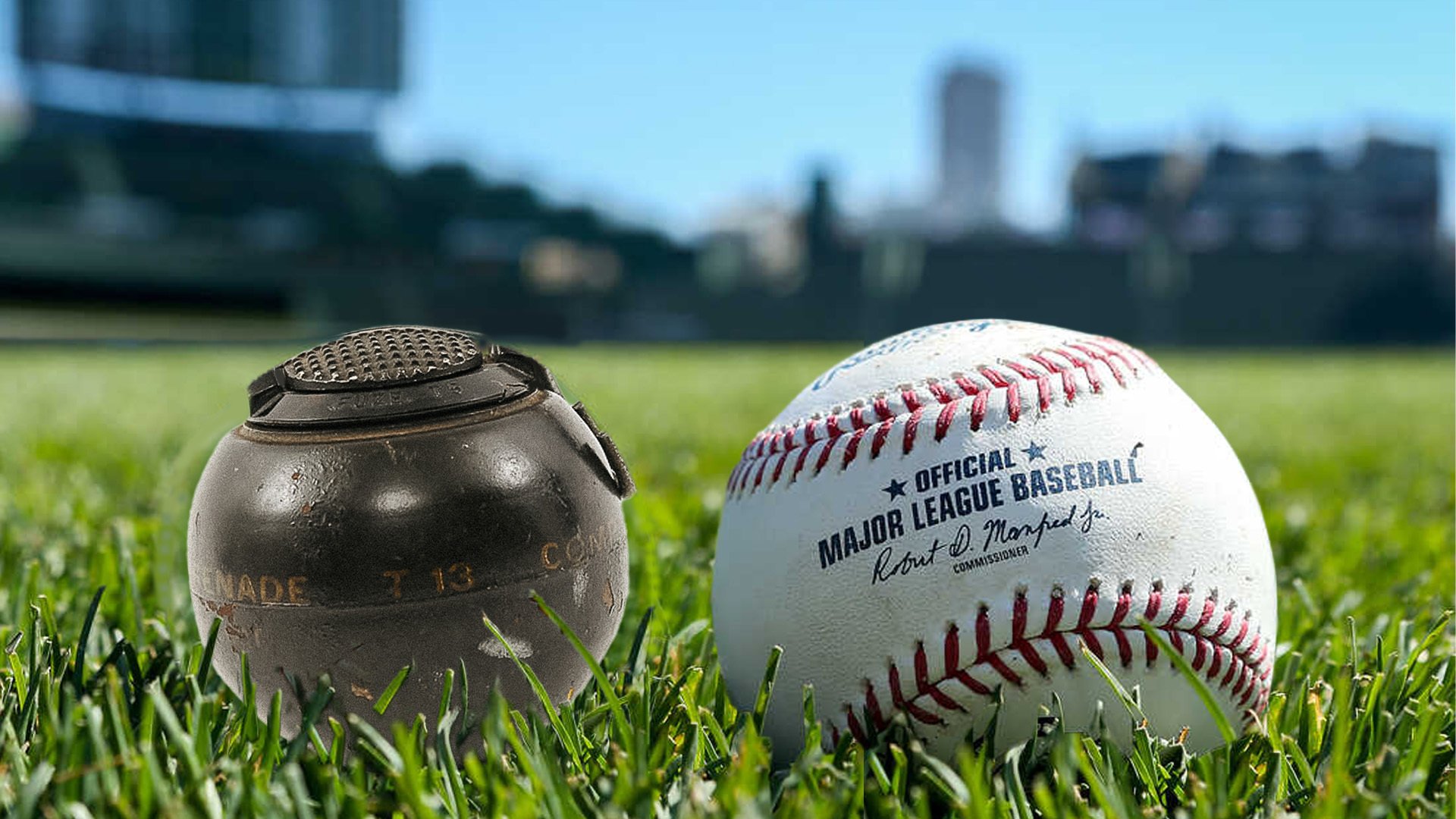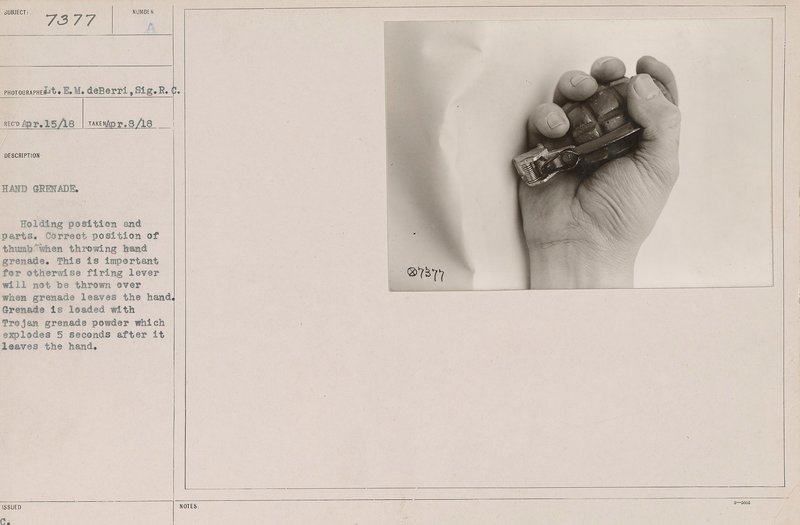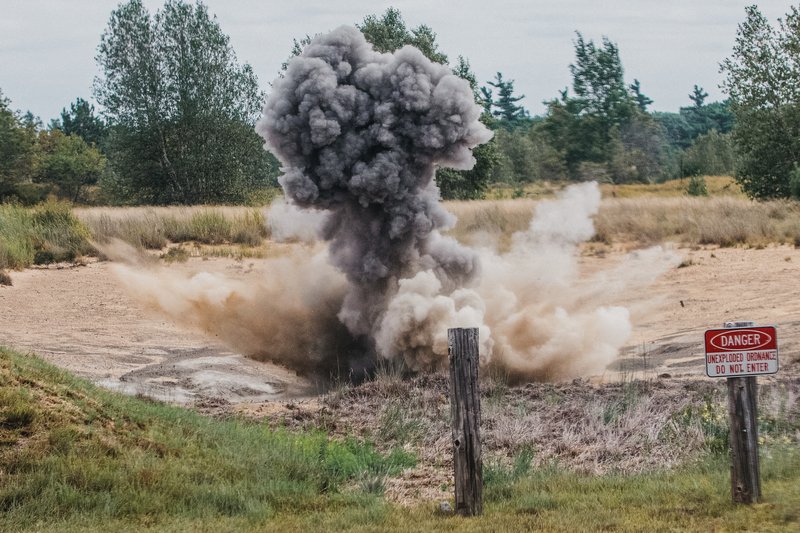How America’s Love for Baseball Shaped the Grenades Carried by US Troops

The T-13 hand grenade developed by the Office of Strategic Services, the precursor to the CIA, left, next to a Major League Baseball, right. Composite by Matt Fratus/Coffee or Die.
The United States military entered World War I in the spring of 1917. It quickly became clear that American doughboys were ill-equipped for fighting in the trenches of Europe. One crucial tool they lacked was a grenade that could be thrown far, fast, and accurately.
The Mk1 fragmentation grenade, issued to American troops during World War I, proved unreliable in combat. For one, detonating the Mk1 required several steps that had to be performed in a specific sequence. To initiate the time fuse, the thrower had to pull the safety pin, remove the top cap, then twist the lever with their thumb. In the chaos of battle, soldiers would often miss a step and throw an untriggered grenade at the enemy, only to have it tossed back at them fully armed.

In World War I, "baseball grenades" were an experimental concept relying on the logic that since many young men of the generation grew up playing on sandlots, then they would be equally capable of throwing a baseball-shaped hand grenade with precision. Photo courtesy of the website JF Ptak Science Books.
Once the need to replace the Mk1 became obvious, the US Army began exploring plans for a hand grenade that was similar to it in size and weight but easier for troops to arm and throw. Ultimately, the Army settled on the idea to field a grenade that resembled a baseball.
The logic was obvious. Many young men of that generation had grown up playing “America’s pastime,” whether in sandlots or on the streets. So it stood to reason that there were plenty of soldiers in the ranks for whom throwing a baseball-shaped grenade with precision would come quite naturally. As one Army sergeant explained it to a reporter at the time, “The French and Germans throw beer and wine bottle grenades, and what would come more handy to the hand of the average American soldier than a baseball grenade?”

Instructional document showing correct throwing technique of the Mk1 hand grenade used in World War I. Wikimedia Commons photo.
The first so-called “baseball grenades” were developed in 1916. One of the more promising prototypes was designed by a former pitcher for the US Military Academy at West Point’s baseball team. To throw it far and accurately, however, the thrower had to wear a special glove that put extra spin on the grenade so that it traveled through the air like a curveball. Perhaps for that reason, the prototype wasn’t greenlit for production, nor were any of the other baseball grenade concepts pitched to the Army during World War I.
Instead, in 1918, the US War Department upgraded the Mk1. The improved version, called the Mk2, had a more reliable time fuse than the Mk1, was shaped like a pineapple, and was designed to be thrown overhand like a baseball. Though it never saw action in World War I, it was the standard-issue hand grenade for American GIs at the onset of World War II.

The explosion from a M67 Fragmentation Hand Grenade during a live grenade range, Aug. 21, 2018, at Range 17 in Fort Drum, New York. US Army photo by Sgt. Austin Parker.
Meanwhile, the baseball grenade concept continued to be refined. In 1944, the Office of Strategic Services — the precursor to the CIA — introduced the T-13 hand grenade. Nine-and-a-half inches in circumference and weighing about 5 ounces, the T-13 had the exact same dimensions as a Major League baseball. The grenade also exploded on impact, hence why OSS operatives nicknamed it the “BEANO,” shorthand for “beanball,” a slang term in baseball used to describe a pitch thrown directly at a batter with the intention of hurting them.
Thousands of T-13s were shipped to Europe ahead of D-Day and used by frontline troops in Normandy. However, after several American soldiers were killed by T-13s that prematurely detonated, production of the grenades was halted and never resumed.

A US Marine with 2nd Transportation Battalion places an M67 grenade into a grenade pouch during exercise Potomac Restore on Camp Lejeune, North Carolina, May 6, 2022. US Marine Corps photo by Lance Cpl. Jessica J. Mazzamuto.
After World War II, the US military shelved the baseball grenade concept, opting instead for the lemon-shaped M26. M26-series grenades (M26/M61/M57) replaced the Mk2 to become the standard-issue grenades for American troops in Korea and, later, during the early years of the Vietnam War.
Then, in the late 1960s, the baseball grenade returned, this time in the form of the M33. The M33 — eventually renamed the M67 — was almost identical in shape and size to a baseball, but it was noticeably heavier at 14 ounces. Despite its weight, the grenade proved highly effective in the jungles, rice paddies, hamlets, and underground tunnel complexes of Vietnam. It was so effective, in fact, that to this day, the M67 remains the standard-issue grenade for American combat troops.
Read Next: Flash Bangs: Less Lethal But Still Dangerous

Matt Fratus is a history staff writer for Coffee or Die. He prides himself on uncovering the most fascinating tales of history by sharing them through any means of engaging storytelling. He writes for his micro-blog @LateNightHistory on Instagram, where he shares the story behind the image. He is also the host of the Late Night History podcast. When not writing about history, Matt enjoys volunteering for One More Wave and rooting for Boston sports teams.
BRCC and Bad Moon Print Press team up for an exclusive, limited-edition T-shirt design!
BRCC partners with Team Room Design for an exclusive T-shirt release!
Thirty Seconds Out has partnered with BRCC for an exclusive shirt design invoking the God of Winter.
Lucas O'Hara of Grizzly Forge has teamed up with BRCC for a badass, exclusive Shirt Club T-shirt design featuring his most popular knife and tiomahawk.
Coffee or Die sits down with one of the graphic designers behind Black Rifle Coffee's signature look and vibe.
Biden will award the Medal of Honor to a Vietnam War Army helicopter pilot who risked his life to save a reconnaissance team from almost certain death.
Ever wonder how much Jack Mandaville would f*ck sh*t up if he went back in time? The American Revolution didn't even see him coming.
A nearly 200-year-old West Point time capsule that at first appeared to yield little more than dust contains hidden treasure, the US Military Academy said.












